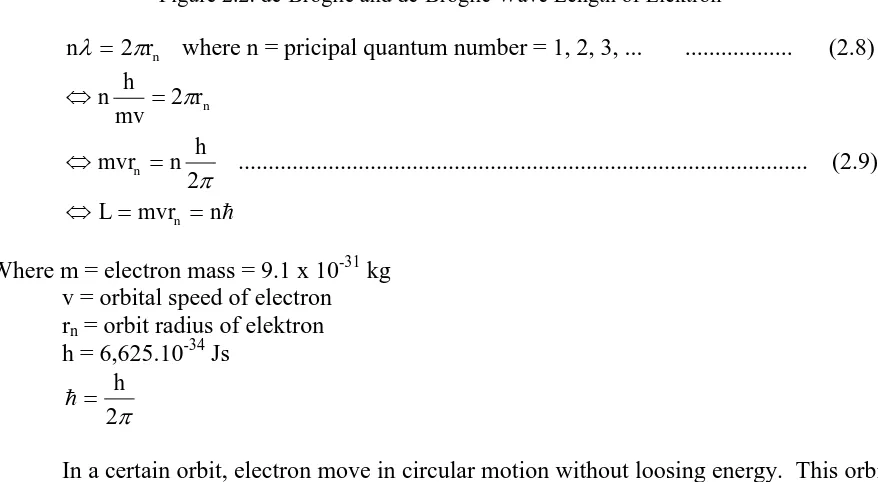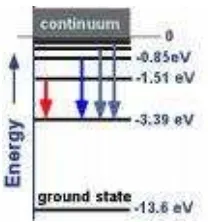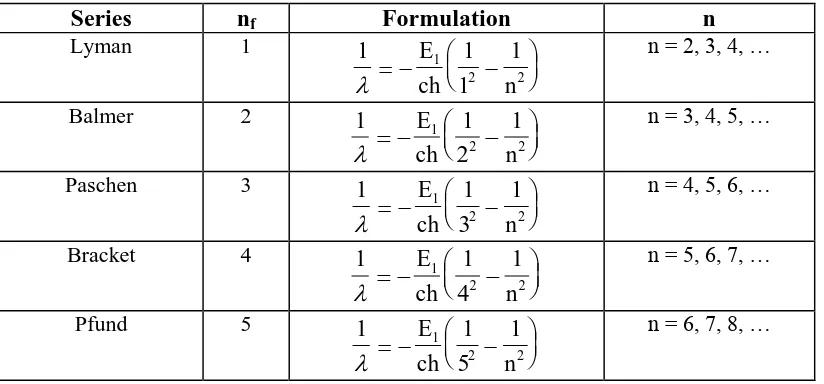CHAPTER 2
BOHR ATOMIC MODEL
A. Introduction
Several concepts as foundation of the Bohr atomic model are:
1. Photon concept which describe the electromagnetic wave as quanta energy that behave as particle give a new paradigm in the study of atomic structure.
2. The experiment result about the hydrogen atomic structure could not be explained theoretically until 1913. The devices to measure the light spectrum developed in the last of nine teen century. The observation about the spectrum which emitted by atomic gas is a line spectrum.
In 1885, JJ Balmer has found a simple empirical formula related with the frequency of hydrogen spectrum in visible area:
Table 2.1. Spectrum of Balmer Series Hydrogen Line
Spectrum
Wave Length (Angstrom) Frequency
(1014 Hz) The Balmer formula for the wave length is:
Each wave length can be determined by substitute integer number n>2, as n=3, 4, 5, ... In the frequency the formula can be written: stated in angstrom/sekon, it obtained:
3. In 1908 Paschen found another spectrum of hydrogen atom in infra red area. The series is according the formula:
Balmer and Paschen series can be written in: Balmer series by defining the wave length reciprox:
1
Using this definition, it is obtainen:
In atomic physics, Bohr atomic model stated that atom consist of nucleus which is rotated by electrons in certain orbits. The experiment result show that the hydrogen spectrum is line spectrum that called Balmer series.
Figure 2.1. Niels Bohr and his Nitrogen Atomic Model
These are several Bohr idea that is used as a foundation of Bohr model: 1. Electron orbits have a discret energy which is quantified.
4. Electron’s orbits which permitted depend on the quantification of the orbital angular momentum:
2 h n n
L .
Bohr atomic model some time known as a semiclassic model, because it combines classical and quantum physics.
B. Bohr Postulates
Postulate 1
Hydrogen atom consist of one electron which moves in a circular orbit rotates the nucleus, the electron motion is effected by Coulomb attractive force according the classical mechanics. Postulate 1 give the arrangement of hydrogen atom and force which exert between nucleus and electron.
Postulate 2
The stable orbits of electron is belong to electron which has an angular momentum equal to
2 h n n
L . Postulate 2 give quantification of angular momentum anda quantification of electron orbit.
Postulate 3
In a stable orbit the electron which rotates the nucleus does not emit lectromagnetic energy. It means, the total energy of atom does not change. Postulate 3 states that electron in stationer orbit does not emit electromagnetic energy.
Postulat 4
Electromagnetic energy is emitted by atomic system if electron jumps from certain orbit to another orbit is occurred. The frequency of electromagnetic wave which emitted by atom is:
h E Ei f
. Postulate 4 states that in the electron transition from a certain stable otbit to another stable orbit emits photon which its energy equal to the difference of the two orbits.
C. Quantification of Angular Momentum L
A certain circular orbit has angular momentum equal to integer number times de-Broglie wave length.
Figure 2.2. de-Broglie and de-Broglie Wave Length of Elektron
n 2rn where n = pricipal quantum number = 1, 2, 3, ... ... (2.8)
n mvr L
h n mvr
r mv
h n
n n
n
2 2
... (2.9)
Where m = electron mass = 9.1 x 10-31 kg v = orbital speed of electron rn = orbit radius of elektron h = 6,625.10-34 Js
2 h
In a certain orbit, electron move in circular motion without loosing energy. This orbit is known stationer orbit:
D. Wave length of orbital electron:
h mv
h
m e
mr h
me mr
o
o
4 4
h e
r m
o
4
………...………. (β.10)
E. Requirement of stable orbit of electron:
Electron orbit will bw stable if the orbit circumference of electron equal to integer number times de-Broglie wave length of the electron.
n 2rn where n = 1, 2, γ, …
as Bohr radius. Equation (2.11) can be written in equation (2.12):
rn n a2 o ………..…...….. (β.1β) Based on equation (2.12) it can be described electron only move in certain orbit with certain radius without emit electromagnetic energy.
Each electron orbit have each energy state. If electron jump from energy state Ei to the lowe energy state Ef , it will be emitted photon energy hυ.
where υ frequency photon emitted.
On the other hand if electron jump from lower energy state to the higher energy state, so energy is absorbed by atom. It means that electron does not emit energy continously. Energy states for hydrogen atom in n orbit:
E e
Figure 2.3 Hidrogen’s energy states
All of energy states are negative, it means electrons do not have enough energy to leave nucleus. The lowest energy state E1 is called ground state), and the higher energy stated E2, E3, E4, ... is called excited state. For n=∞, E∞=0, it means electron is not binded again by nucleus to form
atom.
Energy required to release electron from its ground state is called ionization energy. Ionization energy of hydrogen atom:
eV E
H atom
E E
ioniza tion ioniza tion
6 , 13 .
1
……….. (β.16)
F. Spectral Series
If the initial quantum number ni (higher energy) and the final quantum number nf (lower energy), when exitation of electron is ocrred photon energy is emitted from atom.
E E E
h E E
foton awal akhir
i f
Frequence of photon which emitted:
1
1
1 1
1 2
1 2
1
2 2
h E E
h E n
E n E
h n n
i f
i f
f i
( )
Because of c so the photon frequency:
c E
h nf ni
1
2 2
1 1
Table 2. 2. Spektral Series
Calculation of Ryberg constant ( R ):
hydrogen atom:
n=
n=5 H Pfund Series n=4
H Bracket Series n=3
Paschen Series H
n=2 INFRA RED Balmer Series
(visible area)
n=1
Lyman Series (ultra violet)
Figure 2.4 Spektral Series in Hydrogen Atom
In Figure 2.5 below, it shown Balmer series.
Figure 2.5 Spectrum of Balmer Series
G. Problems
1. Analize equation of hydrogen atom spectrum based on Bohr theory!
2. Determine 5 energy states of hydrogen atom based on the energy quantification principle! 3. Determine the minimum voltage must be used in order electron in hydrogen atom can be
released from its ground state.
H. Reference
Alimufi Arief, dkk. 2002. Buku Materi Pokok Fisika Atom. Jakarta: Pusat Penerbitan Universitas Terbuka.
Anonim. 2007. Bohr Model. Wikipedia, the free encyclopedia.
http://en.wikipedia.org/wiki/Bohr_model.
Hariyadi S. 1983. Model Atom Hidrogen Menurut Bohr. Bandung: ITB.




